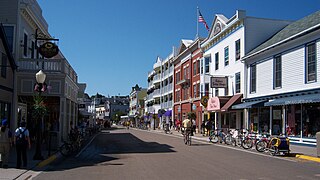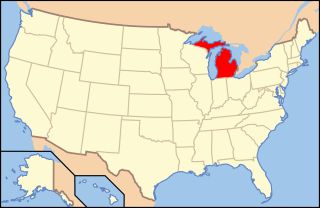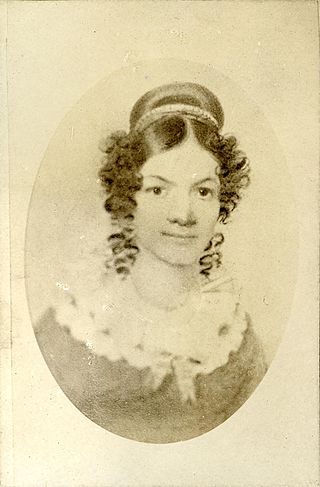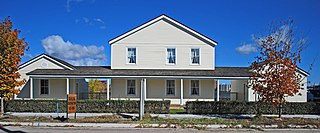
Mackinac Island is an island and resort area, covering 4.35 square miles (11.3 km2) in land area, in the U.S. state of Michigan. The name of the island in Odawa is Michilimackinac and "Mitchimakinak" in Ojibwemowin meaning "Great Turtle". It is located in Lake Huron, at the eastern end of the Straits of Mackinac, between the state's Upper and Lower Peninsulas. The island was long home to an Odawa settlement and previous indigenous cultures before European colonization began in the 17th century. It was a strategic center of the fur trade around the Great Lakes. Based on a former trading post, Fort Mackinac was constructed on the island by the British during the American Revolutionary War. It was the site of two battles during the War of 1812 before the northern border was settled and the US gained this island in its territory.

Schoolcraft County is a county located in the Upper Peninsula of the U.S. state of Michigan. As of the 2020 census, the population was 8,047, making it Michigan's fourth-least populous county. The county seat is Manistique, which lies along the northern shore of Lake Michigan. The county is named in honor of Henry Schoolcraft, who explored the area with the expedition of Lewis Cass. The county was founded in 1843 and organized in 1876. The county is largely rural and forested, with much of its western portion within Hiawatha National Forest.

Emmet County is a county located in the U.S. state of Michigan. It is the northernmost county in the Lower Peninsula. As of the 2020 Census, the population was 34,112, making it the second-most populous county in Northern Michigan. The county seat is Petoskey, which is also the county's largest city.

Mackinac Island is a city in Mackinac County in the U.S. state of Michigan. As of the 2020 census, the city had a population of 583.

Mackinaw City is a village at the northernmost point of the Lower Peninsula of Michigan. Divided between Cheboygan and Emmet counties, Mackinaw City is the located at the southern end of the Mackinac Bridge, which carries Interstate 75 over the Straits of Mackinac to the Upper Peninsula. Mackinaw City, along with St. Ignace, serves as an access point to Mackinac Island. For these reasons, Mackinaw City is considered one of Michigan's most popular tourist attractions.

Hiawatha National Forest is a 894,836-acre (362,127 ha) National Forest in the Upper Peninsula of the state of Michigan in the United States. Commercial logging is conducted in some areas. The United States Forest Service administers this National Forest; it is physically divided into two subunits, commonly called the Eastside 46°14′N84°50′W and Westside 46°08′N86°40′W.

Henry Rowe Schoolcraft was an American geographer, geologist, and ethnologist, noted for his early studies of Native American cultures, as well as for his 1832 expedition to the source of the Mississippi River. He is also noted for his major six-volume study of Native Americans commissioned by Congress and published in the 1850s.

The following is an alphabetical list of articles related to the U.S. state of Michigan.

Fort Mackinac is a former British and American military outpost garrisoned from the late 18th century to the late 19th century in the city of Mackinac Island, Michigan, on Mackinac Island. The British built the fort during the American Revolutionary War to control the strategic Straits of Mackinac between Lake Michigan and Lake Huron, and by extension the fur trade on the Great Lakes. The British did not relinquish the fort until thirteen years after the end of the American Revolutionary War. Fort Mackinac later became the scene of two strategic battles for control of the Great Lakes during the War of 1812. During most of the 19th century, it served as an outpost of the United States Army. Closed in 1895, the fort has been adapted as a museum on the grounds of Mackinac Island State Park.

Mackinac Island State Park is a state park located on Mackinac Island in the U.S. state of Michigan. A Lake Huron island, it is near the Straits of Mackinac. The island park encompasses 1,800 acres (7.3 km2), which is approximately 80% of the island's total area. The park is also within the boundaries of the city of Mackinac Island and has permanent residents within its boundaries. M-185 circles the perimeter of the park as the only motorless highway in the state due to the island's ban of automobiles. The park is governed by the Michigan Department of Natural Resources and the Mackinac Island State Park Commission. On July 15, 2009, the park celebrated its 20 millionth visitor.

The Mission Church is a historic Congregational church located at the corner of Huron and Tuscott Streets on Mackinac Island, Michigan, United States. Built in 1829, it was the oldest surviving church in the state of Michigan. In 1971, the Mission Church was listed on the National Register of Historic Places.

The Mission House, on Mackinac Island, is a historic structure owned by the state of Michigan. Built in 1825, it is listed on the National Register of Historic Places and is operated as part of the Mackinac Island State Park. The Mission House is a wood-frame structure covered in clapboard siding and constructed in a U shape. The center section is three stories, and the flanking wings are two stories. The front facade has a single-story porch covering the entrance in the center.
Ozhaguscodaywayquay, also called Susan Johnston, was an Ojibwe woman and was an important figure in the Great Lakes fur trade before the War of 1812, as well as a political figure in Northern Michigan after the war. She married the British fur trader John Johnston, an inland trader of the North West Company. They had prominent roles in the crossroads society of Sault Ste. Marie, Michigan and the territory before 1830, and entertained notable visitors from a variety of disciplines. Their daughter Jane Johnston Schoolcraft has become recognized as the first Native American literary writer in the United States.

Jane Johnston Schoolcraft, also known as Bamewawagezhikaquay is the one of earliest Native American literary writers. She was of Ojibwe and Scots-Irish ancestry. Her Ojibwe name can also be written as O-bah-bahm-wawa-ge-zhe-go-qua, meaning "Woman of the Sound [that the stars make] Rushing Through the Sky." From babaam- 'place to place' or bimi- 'along', wewe- 'makes a repeated sound', giizhig 'sky', and ikwe 'woman'. She lived most of her life in Sault Ste. Marie, Michigan.

The St. Ignace Mission is located in a municipal park known as Marquette Mission Park. It was the site of a mission established by Jesuit priest, Father Jacques Marquette, and the site of his grave in 1677. A second mission was established at a different site in 1837, and the chapel was moved here in 1954. The second mission chapel is the oldest Catholic church in Michigan and Wisconsin. The St. Ignace Mission was designated a Michigan State Historic Site in 1956, and was declared a U.S. National Historic Landmarks in 1960, one of the earliest sites recognized. The mission chapel serves as the Museum of Ojibwa Culture.
John Johnston (1762–1828) was a wealthy and successful British fur trader for the North West Company at Sault Ste. Marie when it was still Canadian territory before the War of 1812. After the border became redefined, Johnston was a prominent citizen and leader in the Michigan Territory of the United States, although he never became a US citizen.
The Mackinac Island State Park Commission is an appointed board of the State of Michigan that administers state parklands in the Straits of Mackinac area. It performs public activities under the name Mackinac State Historic Parks. Park units include Mackinac Island State Park including Fort Mackinac and certain properties within the historic downtown of Mackinac Island, Michigan; Colonial Michilimackinac including Fort Michilimackinac and Old Mackinac Point Lighthouse; and Historic Mill Creek Discovery Park. It is assigned to the Michigan Department of Natural Resources.

Elmwood, also known as the Henry Rowe Schoolcraft House, the Schoolcraft House or the Indian Agency, is a frame house located at 435 East Water Street in Sault Ste. Marie, Michigan. It was designated a Michigan State Historic Site in 1956 and listed on the National Register of Historic Places in 1974.

The John Johnston House is a private house located at 415 Water Street in Sault Ste. Marie, Michigan. It was listed on the National Register of Historic Places in 1970 and designated a Michigan State Historic Site in 1958.

















